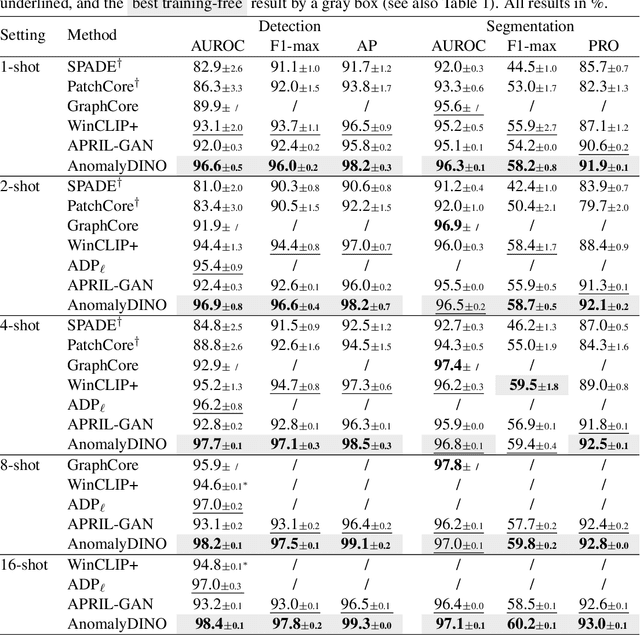Simon Damm
AnomalyDINO: Boosting Patch-based Few-shot Anomaly Detection with DINOv2
May 23, 2024



Abstract:Recent advances in multimodal foundation models have set new standards in few-shot anomaly detection. This paper explores whether high-quality visual features alone are sufficient to rival existing state-of-the-art vision-language models. We affirm this by adapting DINOv2 for one-shot and few-shot anomaly detection, with a focus on industrial applications. We show that this approach does not only rival existing techniques but can even outmatch them in many settings. Our proposed vision-only approach, AnomalyDINO, is based on patch similarities and enables both image-level anomaly prediction and pixel-level anomaly segmentation. The approach is methodologically simple and training-free and, thus, does not require any additional data for fine-tuning or meta-learning. Despite its simplicity, AnomalyDINO achieves state-of-the-art results in one- and few-shot anomaly detection (e.g., pushing the one-shot performance on MVTec-AD from an AUROC of 93.1% to 96.6%). The reduced overhead, coupled with its outstanding few-shot performance, makes AnomalyDINO a strong candidate for fast deployment, for example, in industrial contexts.
Learning Sparse Codes with Entropy-Based ELBOs
Nov 03, 2023Abstract:Standard probabilistic sparse coding assumes a Laplace prior, a linear mapping from latents to observables, and Gaussian observable distributions. We here derive a solely entropy-based learning objective for the parameters of standard sparse coding. The novel variational objective has the following features: (A) unlike MAP approximations, it uses non-trivial posterior approximations for probabilistic inference; (B) unlike for previous non-trivial approximations, the novel objective is fully analytical; and (C) the objective allows for a novel principled form of annealing. The objective is derived by first showing that the standard ELBO objective converges to a sum of entropies, which matches similar recent results for generative models with Gaussian priors. The conditions under which the ELBO becomes equal to entropies are then shown to have analytical solutions, which leads to the fully analytical objective. Numerical experiments are used to demonstrate the feasibility of learning with such entropy-based ELBOs. We investigate different posterior approximations including Gaussians with correlated latents and deep amortized approximations. Furthermore, we numerically investigate entropy-based annealing which results in improved learning. Our main contributions are theoretical, however, and they are twofold: (1) for non-trivial posterior approximations, we provide the (to the knowledge of the authors) first analytical ELBO objective for standard probabilistic sparse coding; and (2) we provide the first demonstration on how a recently shown convergence of the ELBO to entropy sums can be used for learning.
Towards the Detection of Diffusion Model Deepfakes
Oct 26, 2022Abstract:Diffusion models (DMs) have recently emerged as a promising method in image synthesis. They have surpassed generative adversarial networks (GANs) in both diversity and quality, and have achieved impressive results in text-to-image and image-to-image modeling. However, to date, only little attention has been paid to the detection of DM-generated images, which is critical to prevent adverse impacts on our society. Although prior work has shown that GAN-generated images can be reliably detected using automated methods, it is unclear whether the same methods are effective against DMs. In this work, we address this challenge and take a first look at detecting DM-generated images. We approach the problem from two different angles: First, we evaluate the performance of state-of-the-art detectors on a variety of DMs. Second, we analyze DM-generated images in the frequency domain and study different factors that influence the spectral properties of these images. Most importantly, we demonstrate that GANs and DMs produce images with different characteristics, which requires adaptation of existing classifiers to ensure reliable detection. We believe this work provides the foundation and starting point for further research to detect DM deepfakes effectively.
 Add to Chrome
Add to Chrome Add to Firefox
Add to Firefox Add to Edge
Add to Edge